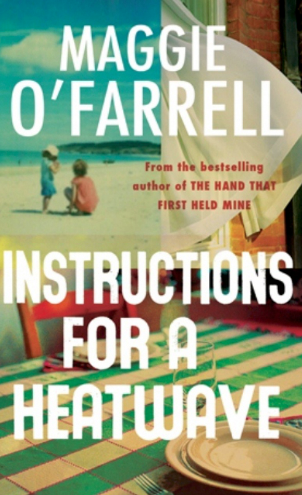
I’m so behind with book reviews that it’s highly unlikely, I’ll ever catch up. This would have been one of many I was going to put aside “for later”, but the title’s too fitting to postpone reviewing it. And it was enjoyable.
The heatwave of the title refers to the heatwave of 1976, one of the worst the UK has ever seen. I don’t know anyone who was alive back then, no matter how small, who wouldn’t remember it. While it’s possibly as hot now as it was then, the heat started earlier, I think, in June and there were massive water shortages. Let’s hope that it won’t come to that. Although it looks dire already. “Over here”, where I live, Continental Europe, it’s even hotter. And, just like in the UK, we have no air conditioning. In Switzerland it’s even forbidden to have them in your own home. Small ones, yes, but they don’t help much. Before diving into the review, let me moan some more – yesterday, the thermometer in our flat showed 35°! Only two degrees less than outside. Sleeping, you wonder? Not so much. My poor cats crawl into dark corners, hoping dark means cool and stay there until the evening. Normally, they run around all day. Unfortunately, he’s afraid of the fan, while she enjoys it
Now on to Maggie O’Farrell. As I mentioned already, Instructions For a Heatwave is set in 1976 during the heatwave and tells the story of the Riordan family. One morning, the dad, Robert Riordan, leaves the house and doesn’t come back. His wife Gretta is shocked and flustered. She calls her children hoping they will come and help her. Already the first phone calls show the family dynamics. There are misunderstandings, half-truths, accusations, exaggerations, tensions. And the three children are facing troubles of their own, that are now, through this family emergency, magnified. At the same time, the emergency shows how frail their family bonds are, how dysfunctional. Gretta is a hypochondriac. She changes subjects when she feels she doesn’t want to talk about something and that is often. She pops pills, makes stuff up and has her kids constantly on alert. Some of the reasons for her behavior will be revealed later.
Michael Francis is the oldest sibling and in the middle of his own family crisis. It may very well be that his wife, who is reinventing herself, will leave him. He’s not entirely without fault though. Monica, the first daughter, married for the second time, is also doubtful about the future of her marriage. And Aoife, the youngest, is in New York, trying desperately to hold on to a life she loves but that is threatened because it’s built on a lie – nobody knows that she’s a functional illiterate.
When they hear of their dad’s disappearance they all return home. At first, the reunion is frosty and awkward. There are too many things that have been left unsaid in the past and too many family secrets. The biggest is the reason for their dads’ disappearance.
It will take them a few days to sort some things out and then they take a family trip to Ireland, where the parents originally come from.
Instructions for a Heatwave is in many ways an astonishing book. It’s so intricately told, the stories are so tightly interwoven that I was constantly wondering – how did she do that? She moves in out of characters’ minds, switches from the present to the past and back again, but it’s never confusing because it’s so well done.
This is the story of a dysfunctional family but one with hope. They do not give up on each other nor on themselves. Gretta was possibly my favorite character although she reminded me of my late mother (minus my mother’s meanness that is). It’s fascinating to see a character description that resonates so much. Just like Gretta, my mother would always change the subject if she didn’t want to talk about something, pretending she hadn’t heard what had been said and then pretending she had an attack of something (cough, sickness, stomach cramps, “nerves”) and urgently needed her pills. Also, like Gretta, she would start chatting with anyone, finding out family stories and other people’s secrets without ever revealing any of her own. Since the Riordan’s are Irish and Catholics, that was something I could relate to as well. Looking back, it was no fun being brought up by a Catholic mother – my dad was anti-clerical, so that balanced things out a bit.
While this book resonated a lot with me because of my own history, I still think anyone who loves complex family stories would like this very much. In the past, I had mixed experiences with Maggie O’Farrell. I loved The Vanishing Act of Esme Lennox, but didn’t care for another one of her books (I think it was After You’d Gone). This rich and lovely novel has put me in the mood to read more by her. Her memoir I Am, I Am, I Am is already on my piles.
